
What are your HEALTH GOALS for the week?🍃🤸♀️🥗🧘♀️🍃

Take time to do the things you LOVE! 🙏🌸

LIFE can be stressful.🤯 Adding these LIFESTYLE STRATEGIES can help improve your HEALTH!🍃🌸
Which best describes your day? Is it busy but everything goes smoothly and you respond positively to whatever challenges arise – or does it feel more like everything is a frantic juggle and you literally cannot take on board a single additional thing? The difference in how a day can feel has much to do with how resilient you are to life’s stressors, because it is your degree of resilience that helps you adapt to an ever-changing environment.
So, how can you build resilience? This begins with acknowledging that life can get stressful (no matter who you are or what you do) and just as you know eating well is good for your physical wellbeing, supporting mental health requires regularly incorporate the lifestyle strategies shown to be beneficial.
While stress is a word used a lot, in this context it refers to the physical response of your body to demands made upon it, whether they are physical, mental or emotional. This is important to understand as ongoing, unmanaged stress can be harmful – the adrenaline you need to power through a really busy day is the same chemical body signal that would be released if something sudden and life threatening occurred to you.

The impact on your body is the same in both scenarios – an increase in blood pressure, faster respiration rate, a rapid heart rate, a decrease in digestive capacity, along with an eventual corresponding decrease in immune function. Known as the ‘stress response’, adrenaline is released as it is useful acutely when you need to run away from, for example, a lion – but it’s not so great if you are exposed to it on a day to day basis.
In fact, being in a heightened state of systemic ‘alarm’ is the reason why many people experience daily fatigue, and is why sometimes innocuous events can begin to trigger a feeling of overwhelm for some people.
For moments of acute stress and tension (which can happen to anyone), there are some stress-busters listed here. However, the aim of building resilience is to reduce the number and/or impact of these acute events. To do this requires your ongoing investment in positive health-based decisions. The foundational tactics with which you can help yourself enjoy a smoother ride through life:
- Start by sprucing up your diet – everyone has to eat so this is a logical place to start. Whilst a balanced wholefood diet is good for general health, some foods are packed with the nutrients specifically required for healthy nervous system function. These include the omega-3 fatty acids (found in oily fish, walnuts, flaxseeds, chia), foods rich in zinc (meat, fish, nuts and seeds again!), magnesium (green leafy vegetables, legumes, figs, avocado, fish and nuts and seeds…again!). Avoid the refined, processed packet foods that include unhealthy fats, sugars and artificial chemicals. Don’t underestimate the impact of dietary improvement for all aspects of health – this is your #1 tactic.
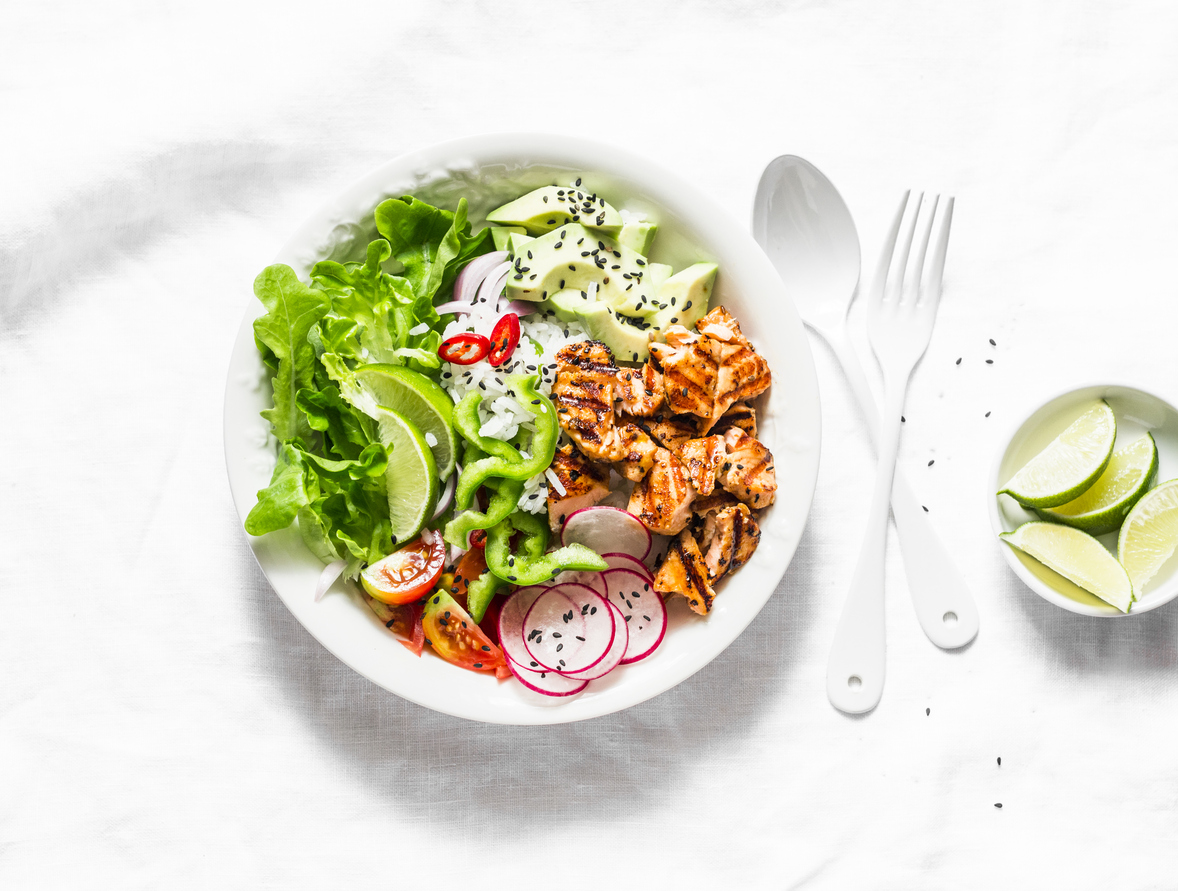
- Carry out a personal sleep audit – between 33% and 45% of adults in Australia sleep poorly, or not enough,[1] which can definitely undermine mental wellbeing. After all, it’s no surprise that things can get a bit too much if you are constantly tired. Aim for 7 to 8 hours of actual sleep a night, and speak to your natural healthcare Practitioner if you are struggling, as there are herbs and nutrients able to help you improve the quality and quantity of your sleep if needed.
- Prioritise moving – time and time again regular exercise has been shown to be specifically beneficial for mental health. Get outdoors if you can and walk, jog, run, cycle, kayak, hill-climb – or head to the gym or a dance class if that’s your preference – as long as it’s happening and regularly. Moving and exercising regularly not only reduces feelings of stress but helps improve memory, sleep, and boosts mood. Australian guidelines recommend 30 minutes of moderate to intensive physical exercise on most days of the week.[2] Incorporating any movement helps so it’s not an ‘all or nothing’ thing – if you rarely move then start small and work up to it – the important thing is it’s regular (every day is best!).
- “Pay attention on purpose” – this is how I once saw the practice of ‘mindfulness’ being described; but all humour aside, the evidence for developing a mindfulness practice is growing with a number of studies showing people reporting less stress, improved physical and emotional health, and better sleep. Plus it can lead to the all-important physical reductions of stress-related biomarkers including blood pressure and cortisol levels (the stress hormone),[3] good for your long-term health also. So what is mindfulness? Well it does not necessarily have to involve meditation, but can instead be a technique applied to everyday life; a mental state whereby you practice focussing on each present moment, and calmly acknowledge your thoughts, feelings, emotions and body sensations – all without judgement. Becoming more mindful gets easier with time and practice, and can help you to remain calm, regulate your thoughts, emotions and reactions, and stay present even in the midst of stressful events.
- Look after your gut bugs – any disturbance in digestive health can contribute to mood swings, anxiety and low mood due to what’s referred to as the ‘gut-brain axis’.[4] The beneficial microbes that reside in your gastrointestinal tract contribute to more than your gut health so are very worth looking after – starting by feeding them well. Ensure you have plenty of fibre in your diet as this is what they feed on primarily. Eat widely from a range of wholegrains, legumes, fresh nuts, and lots of colourful vegetables and fruits (unpeeled where possible). That said, if you have any digestive symptoms this is a sign that something is not quite right; but as this could be due to a range of things, avoid the guesswork and discuss your situation with your healthcare Practitioner.
- Do the things you love – maybe its skateboarding, dancing, reading a good book, dragon boat racing, painting, bushwalking, rebuilding classic cars – whatever it is that rocks your boat, just do it and do it regularly. Think of all the experiences you want to have that you can look back on and be grateful you made time for – that’s probably not working a 60 hour week, every week, with no ‘play-time’. Which would you prefer?

Strategic Supplemental Support
- Nervous system nutrients – like it or not it is not uncommon for adults to get insufficient magnesium from their diets, so this is one of the really helpful supplements for mental wellbeing. Not all magnesium’s are made equal – some are cheap and poorly absorbed and these are the ones too often for sale ‘over the counter’. Also, it can be more economical to use a formula that’s combined with other nervous system supporting nutrients including zinc, B vitamins and taurine to get the best results. Ask a suitably qualified Practitioner (e.g. Clinical Naturopath, Nutritionist) for assistance with the best nutritional solutions for your particular situation.
- Adaptogenic herbs – this is one you may not have heard about but there is a whole class of natural medicines termed ‘adaptogens’ due to their ability to support physical and mental health during times of stress, and which improve performance. Examples include Withania somnifera, Eleuthrococcus senticosus, and Rhodiola rosea. These are best discussed with a qualified Clinical Naturopath or Herbalist, who can take into consideration your health history and any medications you may be taking as well as assess which herb matches your situation best (e.g. do you need a tonifying or calming adaptogenic herb?). They are very different in action.
Help yourself to create a life that goes more smoothly by incorporating as many of the above strategies that you feel you could improve upon. By doing so you can look forward to improved physical, mental and emotional wellbeing for the long-term, whatever comes your way.

[1] Sleep Health Foundation. Australia’s Sleepiness Epidemic. [Internet]. Sydney NSW; Sleep Health Foundation [cited 2018 Sept 19].
[2] Australian Government – Department of Health. Exercise and mental health. [Internet]. Canberra ACT: Australian Government; [cited 2018 Sept 19]. Available from:
[3] Turakitwanakan W, Mekseepralard C, Busarakumtragul P. Effects of mindfulness meditation on serum cortisol of medical students. J Med Assoc Thai. 2013 Jan;96 Suppl 1:S90-5. PubMed PMID: 23724462.
[4] Harvard Health Publishing. The gut-brain connection. [Internet] Boston, MA: Harvard University; 2010-2018. [cited 2018 Sept 19]. Available from:
So true…🍃🌸
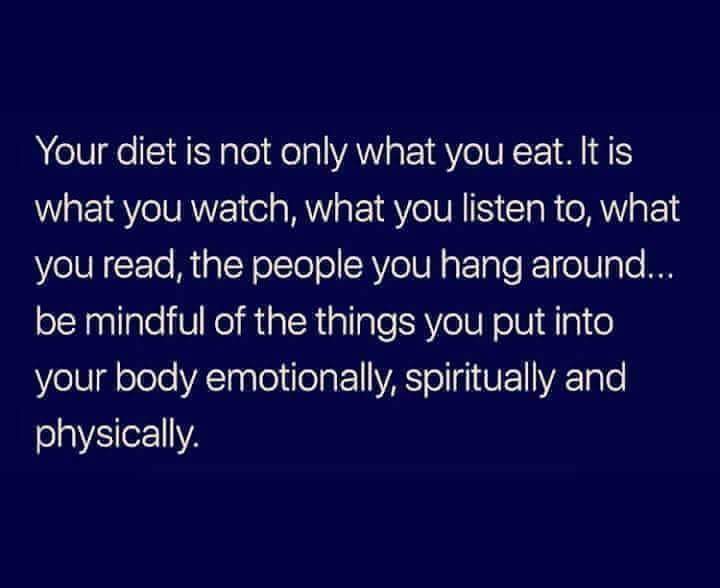
STRESS BUSTING STRATEGIES that invoke CALM.

Modern living has created what seems to be an ever-increasing workload, a culture of demanding emails, texts and social media posts all vying for attention; in addition to financial juggling and all the other ‘life admin’ that keeps each week ticking along. Not that it ends there as, if you are really committed, there is also the need to fit in ‘scheduled down-time’ along with eating well and moving regularly so you can theoretically refill those energy reserves for all of the above…plus there is the need to carve out time to invest in social and family relationships!
When put in this context it’s easy to see that being incredibly busy can also potentially be stressful, depending upon how you are feeling. Because that’s the thing –
the difference between something being exciting and stimulating, or feeling overwhelming and stressful, is your ability to adapt to your environment at any given moment
– which is why some days just seem to fly along easily, and at other times you may be more inclined to throw in the proverbial towel and retreat to a desert island away from it all (wouldn’t that be nice sometimes?).
By all means take a moment to pause and ponder what life might be like on a tropical island – it’ll potentially be calming to visualise a beautiful place – which is what this article is about; what you can do if you find yourself with that less than ideal inner sensation…the one where you are feeling acutely stressed and under pressure to the point of discomfort. This is when you need a rapid ‘stress buster’ – an effective solution to bring about a feeling of calm.
Now it may be you’ve read all about how to eat well and exercise regularly to reduce stress (if not then this will be a topic covered in a future post); however, in the most part these recommendations are more of a long-term action plan to increase your resilience to stressors, rather than acute solutions. That said – a run really can help relieve tension and help you feel amazing, so if that’s your thing and you’ve running shoes to hand, then next time you feel a bit under the pump – go for it! For everyone else, what you need in these instances is to induce what’s called the ‘relaxation response’ to change your internal chemistry and offset that adrenalised feeling of wanting to run away. To keep it simple I’ve listed three tried and tested stress busting strategies below:
Rapid Response Remedies
(1) Put yourself first.
If you find yourself in a situation that has you feeling ‘squeezed’, the best thing you can do (if at all possible) is to remove yourself for a few minutes (or maybe a lot of minutes!) and take steps to actively calm yourself.
Different things will suit different people but strategies could include: excusing yourself to ‘go to the bathroom’; go outside for a five minute walk; or perhaps make yourself a cup of tea (chamomile tea is often around and is a helpful calming herb). While there, take a few deep breaths (see below) to centre yourself – the act of controlled breathing can be very effective.
(2) Breathe.
You are already an expert at breathing as you’ve done it all your life! A simple breathing technique is to do the following:
- Hold your breath and count to seven;
- Breathe out slowly while mentally saying ‘relax’;
- Breathe in slowly for a count of seven;
- Breathe out slowly while mentally saying ‘relax’;
- Continue this for 3 to 5 minutes (depending upon how much time you feel you have).
This exercise can be carried out lying down, sitting or standing and gets easier with practice. Give it a go and you will have an effective calming tool to use anytime, anywhere.

(3) Use an anxiolytic herbal formula.
Named for their ability to also help with feelings of anxiety (not that dissimilar to many peoples description of stress); a number of herbs support the activity of your primary calming neurotransmitter (brain chemical), gamma aminobutyric acid or ‘GABA’. Examples of fast-acting herbs with this soothing quality include passion flower, magnolia, lavender and California poppy. Whilst herbal teas can help, to find the perfect formula for your needs at a dose that will work well the best solution is to speak to a qualified Herbalist or Naturopath who can take into consideration your health history and any medications you may be using.
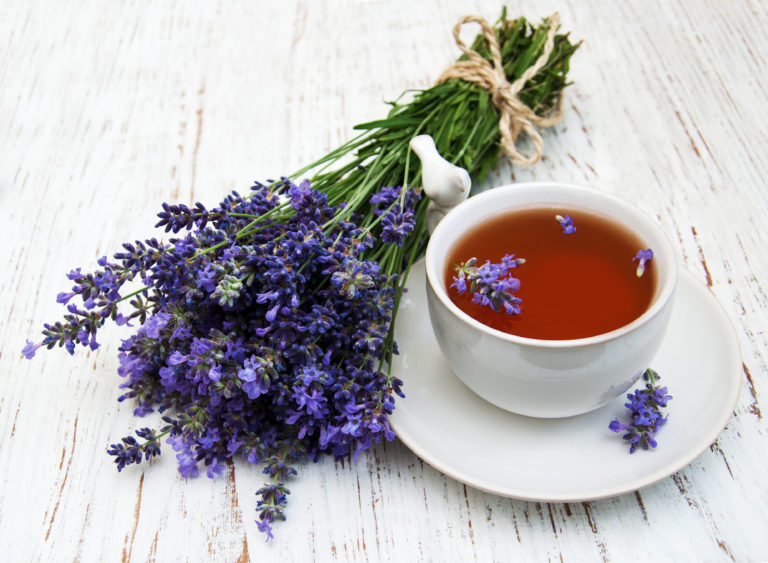
There is no doubt that life is getting busier for most people, and this is putting ever-increasing pressure on our ability to rapidly adapt and remain calm at all times. Look out for the upcoming post on how to build resilience to life’s stressors for the long-term; but in the meantime, keep up your sleeve a few more immediate strategies for those moments when you need to rapidly calm and centre yourself if it becomes necessary.
https://blog.metagenics.com.au/stress-busting-strategies-that-invoke-calm/
Gotta LOVE a LONG WEEKEND!🏖💫

Are YOU eating too much SUGAR?😱
End the sugar-coating

Added sugar is bad for us and health advice tells us we should limit the amount we eat. But food producers aren’t required to label it. And to make matters worse, sugar is hidden in ‘healthy’ foods such as energy bars and fruit and oat clusters too – not just processed junk foods like confectionery and soft drinks.
Many Australians are over-consuming added sugar, but may not even realise it. It’s clear that this situation needs to change.
In this article:
- What are added sugars?
- Added sugar in ‘health’ foods
- What’s really inside the pack?
- CHOICE calls for better labelling
- How to avoid added sugars
- 40+ different names for added sugars
Sugary ‘health’ foods
While on the hunt for a healthy snack at the supermarket, many people would reasonably head to the health food aisle. You know the one – the aisle with all the products claiming to be ‘gluten free’, ‘natural’ or ‘organic’.
What you might not expect to find are so-called healthy products laden with sugar. But we found substantial amounts of added sugar in products presented as good-for-you – in the health food aisle and elsewhere – and in some cases it took some serious sleuthing to determine that this was the case.
- Clif Chocolate Chip Bar, located with other sports and protein supplements, provides ‘nutrition for sustained energy’, but is also 32% sugar in a number of guises including brown rice syrup, cane syrup and barley malt extract.
- Go Natural Twisters Fruit Snack, which we found in the health food aisle, claims to be gluten and additive free. The brand name implies that they’re ‘natural’, but they’re 67% sugars in the form of concentrated apple puree and juice as well as concentrated strawberry juice.
- Uncle Tobys Plus, Peach, Sultanas and Oat Clusters may be “high in wholegrain” and provide “20% of your daily protein”, but there’s no getting away from the fact that its ingredients include multiple added sugars (sugar, invert sugar, malt extract, glucose solids, golden syrup, and honey to name a few), which make up the bulk of its 23% total sugars.
- Weight Watchers Coconut Delight bars are an approved snack under the Weight Watchers weight loss program, but are 37% sugar with invert sugar, barley malt extract and honey all contributing to this total.
A look inside the pack
We analysed the ingredients list and nutrition information panel of some of the foods we found in the health food aisle to show just how much added sugar – compared with other ingredients – they contain.
Go Natural Berry Frugo’s
On the pack: “Goodness tastes better”, “All natural”, “Source of calcium”, “Gluten free”, “No artificial colours, flavours or preservatives”.
In the pack:
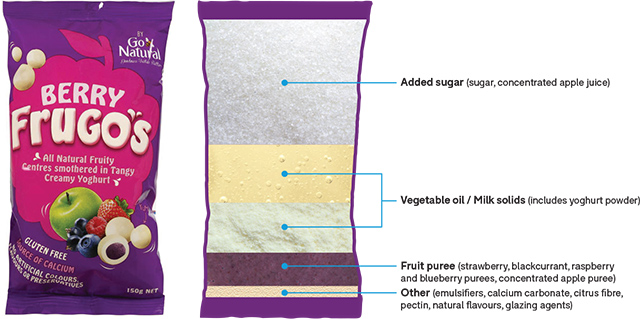
Golden Days Apricot Delight
On the pack: “Natural choice”, “Made with real fruit”, “Gluten free”, “Dairy free”, “No artificial colours”, “No artificial flavours”.
In the pack:
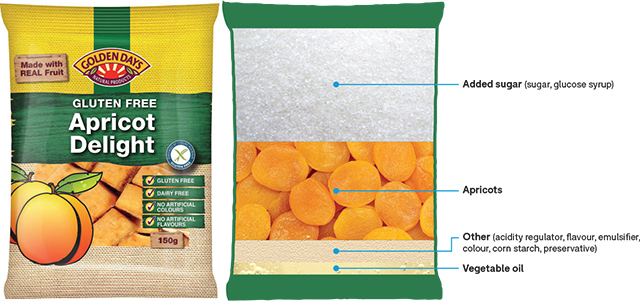
Lowan Cocoa Bombs
On the pack: “Gluten free”, “Low fat”, “No artificial flavours”.
In the pack:
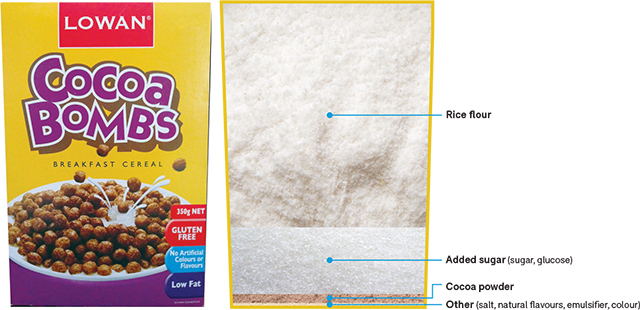
The problem with food labels
Currently there’s no clear way of knowing how much sugar has been added to a food by looking at the label.
You can check the ingredients list to see if a product contains added sugar – the higher up the list, the more sugar the product contains. But added sugars can be disguised under 42 different names and distributed throughout the ingredient list, so they’re not always straightforward to identify and even harder to quantify.
You can also look to the amount of total sugar in a product on the Nutrition Information Panel (NIP). However, this total doesn’t differentiate sugars that have been added by the manufacturer (including glucose, honey and fruit juice concentrates) from those that are intrinsic to the food or one of its ingredients (such as lactose in milk). See What are added sugars for more.
But neither of these labelling elements helps people to easily determine what and how much added sugar is in their food. With so many terms disguising added sugar, and total sugar information sending mixed health messages, it’s evident that current labels are failing consumers.
CHOICE calls for better labelling
We need clear and meaningful added sugar labelling so that we can follow advice to limit added sugar consumption and maintain a healthy diet. There are three main changes we want to see:
- Show the number of teaspoons of sugar in sugar-sweetened drinks. Soft drinks and other sugar-sweetened beverages are the number one contributor to our added sugar intake. Some teenagers are consuming 38 teaspoons of added sugar a day, equivalent to the sugar in four cans of Coke. Identifying the amount of teaspoons of sugar on these products would clearly indicate just how much sugar they contain.
- Make it easy to spot added sugar in the ingredients list. Food companies use over 40 different words for added sugar, including muscovado, rapadura or barley malt extract. We want all added sugar ingredients to be grouped together in the ingredient list so that people can clearly identify them.
- Include added sugar in the nutrition information panel. Currently the nutrition information panel (NIP) only displays total sugars, which includes both intrinsic and added sugar. Intrinsic sugars are found in nutrient-rich foods such as milk, fruit and vegies. These foods are recommended by our dietary guidelines and are part of a healthy and balanced diet. The advice is to reduce the intake of added sugar, which is the sugar added to a product by the food manufacturer. This is why we want the amount of added sugar to be identified separately on the NIP.
The government is currently consulting on improvements to sugar labelling. To have your say on what changes you’d like to see, join our campaign.
How to avoid added sugars
The majority of the sugar we eat comes from processed foods. So labelled or not, the most effective way to curb your added sugar intake (and at the same time improve the nutritional quality of your diet) is to eat a wide variety of fresh fruit, vegetables and other whole foods and minimise the amount of processed foods you eat.
Added sugar FAQs
Different names for added sugar
https://www.choice.com.au/food-and-drink/nutrition/sugar/articles/added-sugar
Do you KNOW how much SUGAR your really eating?🤔

Find out how can YOU IMPROVE your ability to tolerate ALLERGENS and reduce allergic reactivity.🤧🍃

The Immune System in Overdrive
Allergy is essentially a state of immune hyper-reactivity. The body encounters an allergen (a foreign substance such as dust, animal fur, pollen, certain food) that triggers a reaction. In an attempt to restore balance, the immune system mounts an attack to eradicate the allergen. This typically involves mast cells releasing histamine and other immune factors, causing an explosion of inflammation – the end result being uncomfortable allergic symptoms.
While meant to be short-lived, the immune response can continue and become chronic. This may be due to the persistence of the allergen in the environment or the diet (perhaps unidentified), or because the immune system remains in a state of hyper-reactivity as other imbalances in the body (e.g. digestive and immune dysregulation) perpetuate the allergic response.

Building up Tolerance to Your Allergenic Enemies
Many seek relief from allergic symptoms, but how? Allergen avoidance can be restrictive, is not always practical, and fails to address the causes of immune imbalance. While natural medicines with antihistamine and anti-inflammatory properties such as Aller-7® herbal combination, quercetin and bromelain can provide much needed relief from the intensity of allergic symptoms, the real answer is in addressing the immune dysregulation that lies beneath the surface. This approach focuses on increasing tolerance – so you essentially become more accepting of the very allergens you react to!
Building up greater tolerance to environmental and food-borne substances dampens down the immune response, ultimately resulting in no or low reaction upon exposure – to ultimately break the cycle of recurrent allergies.
Reducing Allergic Reactivity
The following treatment strategies can improve your ability to tolerate allergens and reduce allergic reactivity through addressing the underlying drivers:
- Restore immune balance: Allergies reflect a dysregulated immune system; a key treatment target. The medicinal mushroom reishi is effective at restoring the balance of immune cells (T helper 1/T helper 2) to a less allergic state.1,2
- Enhance muscosal defences: Secretory immunoglobulin A (an immune factor found in mucus) helps stop allergens in their tracks, providing the first line of defence against the external environment.3,4 These actions are also enhanced by shiitake mushroom.5
- Heal the gut: The digestive system is the body’s prime regulator of immunity, and research shows that people with allergies have greater intestinal permeability6 (which can allow allergens to pass from the gut to the systemic circulation to trigger immune reactivity). Healing the gut lining can promote a strong barrier and reduce allergy.
- Moderate the gut microbiome: Probiotics support a healthy gut microbiome, meanwhile having profound effects on tipping immune balance from reactivity to a state of calm. In particular, Lactobacillus rhamnosus (LGG®)7 and Lactobacillus paracasei LP-33®8 help regulate the immune system and promote an anti-inflammatory environment; also reducing allergic symptoms including eye symptoms9 and eczema.10
- Support detoxification: Liver detoxification aids removal of environmental toxins and food-based allergens,11 as well as immunologically active material from the body, reducing the intensity of the immune reaction.12

A Fresh Approach to Allergy
It’s time to look at allergies from a fresh perspective. In addition to symptomatic support, addressing gut and immune dysregulation as causative factors in allergy allows you to build up your immune tolerance – decreasing the frequency and/or intensity of your allergies to greatly improve how you feel and function.
For more information on Allergy, plug in your headphones and listen to the Allergy Series podcasts.
References
1. Powell M. The use of Ganoderma lucidum (Reishi) in the management of histamine-mediated allergic responses. Townsend Letter: The Examiner of Alternative Medicine. 2006 May 1(274):78-82.
2. Chang H-M, But P P-H. Lingzhi. Pharmacology and applications of Chinese materia medica Vol 1. Singapore; World Scientific Publishing Co. Pte. Ltd. 2001. 1986. p. 598.
3. Mantis NJ, Rol N, Corthésy B. Secretory IgA’s complex roles in immunity and mucosal homeostasis in the gut. Mucosal Immunol. 2011 Nov 1;4(6):603-11.
4. Corthësy B. Secretory immunoglobulin A: well beyond immune exclusion at mucosal surfaces. Immunopharmacol immunotoxicol. 2009 Jun 1;31(2):174-9.
5. Dai X, Stanilka JM, Rowe CA, Esteves EA, Nieves C Jr, Spaiser SJ, et al. Consuming Lentinula edodes (Shiitake) mushrooms daily improves human immunity: a randomized dietary intervention in healthy young adults. J Am Coll Nutr. 2015;34(6):478-87.
6. Miller A. The pathogenesis, clinical implications and treatment of intestinal hyperpermeability. Alt Med Rev [Internet]. 1997 [cited 2017 Jul 13]. Available at: http://static1.1.sqspcdn.com/static/f/290061/15262306/1322064750827/Intestinal_Hyperpermeability.pdf?token=0vEeWSqCFTx9k6wiH6hvN17fXc8%3D.
7. Fong FLY, Kirjavainen PV, El-Nezami H. Immunomodulatory effects of Lactobacillus rhamnosus GG on dendritic cells, macrophages and monocytes from healthy donors. Journal of Functional Foods. 2015;13:71-79.
8. Peng G, Hsu C. The efficacy and safety of heat-killed Lactobacillus paracasei for treatment of perennial allergic rhinitis induced by house-dust mite. Paediatric Allergy and Immunology. 2005;16:433-438.
9. Peng G, Hsu C. The efficacy and safety of heat-killed Lactobacillus paracasei for treatment of perennial allergic rhinitis induced by house-dust mite. Paediatric Allergy and Immunology. 2005;16:433-438.
10. Kalliomäki M, Salminen S, Poussa T, Isolauri E. Probiotics during the first 7 years of life: a cumulative risk reduction of eczema in a randomized, placebo-controlled trial. J Allergy Clin Immunol. 2007;119:10169-1021.
11. Gao B, Jeong WI, Tian Z. Liver: an organ with predominant innate immunity. Hepatology. 2008 Feb 1;47(2):729-36.
12. Mills S, Bone K. Herbal approaches to system dysfunctions. Principles and Practice of Phytotherapy. 2nd edition. Edinburgh: Churchill Livingstone. 2013. p. 198-199.
Aller-7® is a registered trademark of Network Nutrition.


